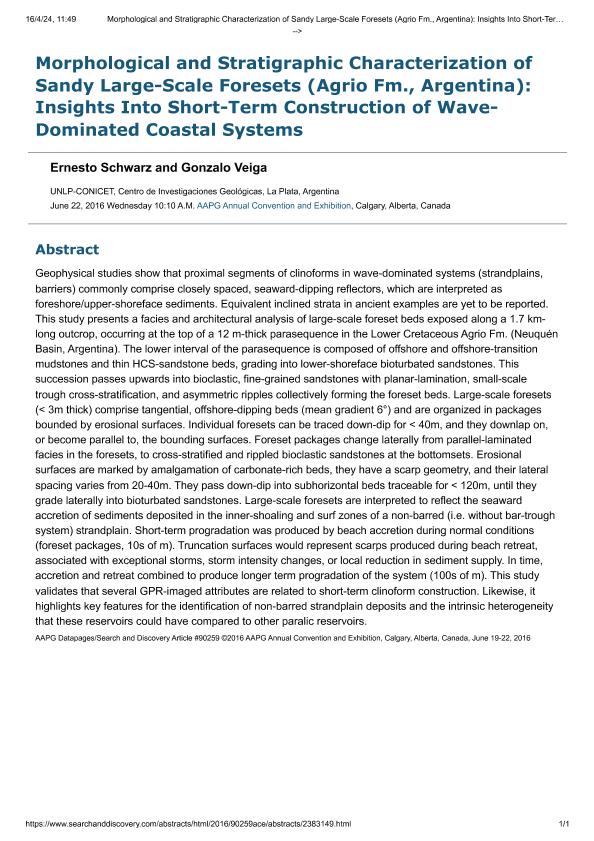Evento
Morphological and stratigraphic characterization of sandy large-scale foresets (Agrio Fm., Argentina): Insights into short-term construction of wave-dominated coastal systems
Tipo del evento:
Exposición
Nombre del evento:
AAPG 2016 Annual Convention and Exhibition
Fecha del evento:
19/06/2016
Institución Organizadora:
American Association of Petroleum Geologists;
Society for Sedimentary Geology;
Título de la revista:
AAPG Annual Convention and Exhibition: Abstract
Editorial:
American Association of Petroleum Geologists
Idioma:
Inglés
Clasificación temática:
Resumen
Geophysical studies show that proximal segments of clinoforms in wave-dominated systems (strandplains, barriers) commonly comprise closely spaced, seaward-dipping reflectors, which are interpreted as foreshore/upper-shoreface sediments. Equivalent inclined strata in ancient examples are yet to be reported. This study presents a facies and architectural analysis of large-scale foreset beds exposed along a 1.7 km-long outcrop, occurring at the top of a 12 m-thick parasequence in the Lower Cretaceous Agrio Fm. (Neuquén Basin, Argentina). The lower interval of the parasequence is composed of offshore and offshore-transition mudstones and thin HCS-sandstone beds, grading into lower-shoreface bioturbated sandstones. This succession passes upwards into bioclastic, fine-grained sandstones with planar-lamination, small-scale trough cross-stratification, and asymmetric ripples collectively forming the foreset beds. Large-scale foresets (< 3m thick) comprise tangential, offshore-dipping beds (mean gradient 6°) and are organized in packages bounded by erosional surfaces. Individual foresets can be traced down-dip for < 40m, and they downlap on, or become parallel to, the bounding surfaces. Foreset packages change laterally from parallel-laminated facies in the foresets, to cross-stratified and rippled bioclastic sandstones at the bottomsets. Erosional surfaces are marked by amalgamation of carbonate-rich beds, they have a scarp geometry, and their lateral spacing varies from 20-40m. They pass down-dip into subhorizontal beds traceable for < 120m, until they grade laterally into bioturbated sandstones. Large-scale foresets are interpreted to reflect the seaward accretion of sediments deposited in the inner-shoaling and surf zones of a non-barred (i.e. without bar-trough system) strandplain. Short-term progradation was produced by beach accretion during normal conditions (foreset packages, 10s of m). Truncation surfaces would represent scarps produced during beach retreat, associated with exceptional storms, storm intensity changes, or local reduction in sediment supply. In time, accretion and retreat combined to produce longer term progradation of the system (100s of m). This study validates that several GPR-imaged attributes are related to short-term clinoform construction. Likewise, it highlights key features for the identification of non-barred strandplain deposits and the intrinsic heterogeneity that these reservoirs could have compared to other paralic reservoirs.
Archivos asociados
Licencia
Identificadores
Colecciones
Eventos(CIG)
Eventos de CENTRO DE INVEST.GEOLOGICAS (I)
Eventos de CENTRO DE INVEST.GEOLOGICAS (I)
Citación
Morphological and stratigraphic characterization of sandy large-scale foresets (Agrio Fm., Argentina): Insights into short-term construction of wave-dominated coastal systems; AAPG 2016 Annual Convention and Exhibition; Calgary; Canadá; 2016; 1-1
Compartir




